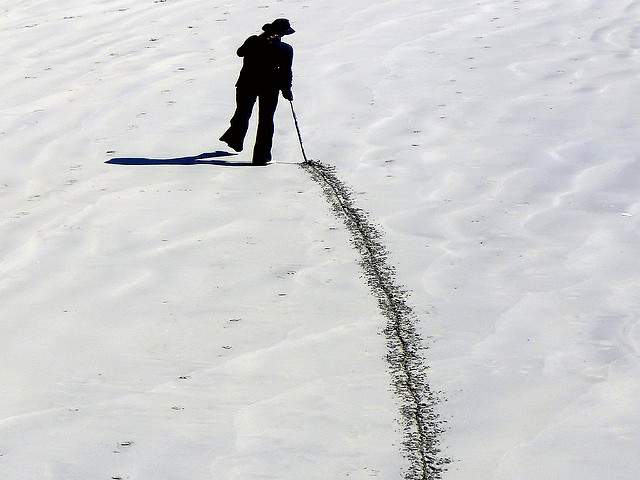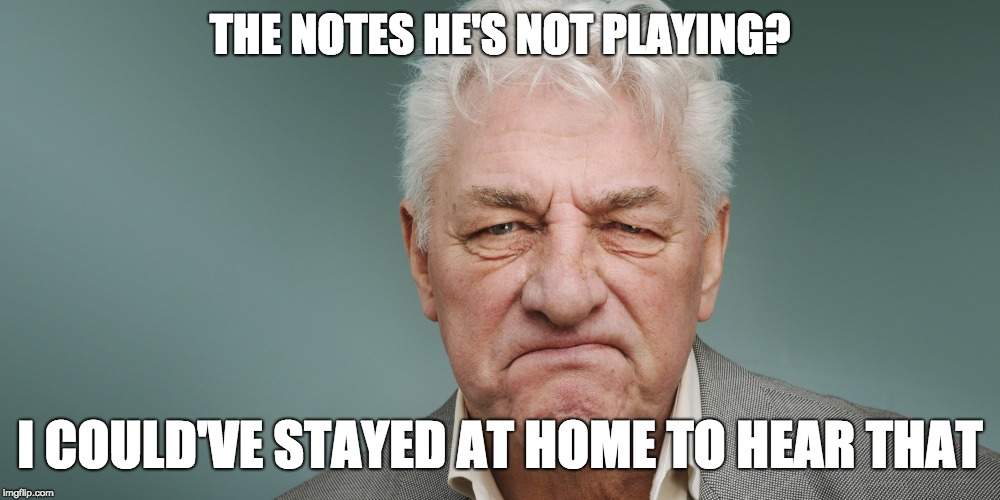I don’t know about you, but I watch as much live footage of my guitar heroes as I possibly can.
It gets me inspired and fired up to practice, and it reminds me why I play guitar and how far I still have to go.
As a music fan it’s fun to watch concerts and live footage, but as a guitar player it’s a lot more than just a bit of entertainment.
There are so many great musical lessons you can learn from seeing the best musicians play live, if you keep your eyes and ears open.
I’m not talking about the kind of “lessons” people usually picture when they think of learning from watching videos.
Guitar lesson videos about famous players are often centered on showing you how to play something note-for-note, like a song or a solo by that artist.
Most of the time, lessons focus on what I call “micro level learning”.
The micro level is where you’re super magnified and zoomed-in on all the specifics and small details of how to play specific musical ideas — put this finger here, then that finger there…
I’m sure you’re already very familiar with this level, so now let me introduce you to the other level:
MACRO Level Learning.
The macro level is when you zoom back out from all the little tiny details, and you take in a much fuller picture of everything that’s going on and concentrate on those features which make the biggest impact.
Macro concepts tend to be more generally applicable to many musical situations, are easier to adopt into your own playing, and they make a much larger difference right away.
You don’t need to do anything special to start learning at the macro level — you just need to open your eyes and ears and start noticing things that are going on right in front of you every day.
Macro learning starts with making simple yet powerful observations about music, that anyone listening closely could make.
From your observations you can derive a piece of useful musical knowledge from what you notice. For example, here is a simple one:
Many legendary rock solos start lower down and finish up high.
Of course that’s not a “rule” that you have to obey. It’s not like that. But it is a valid observation of a distinct feature that lots of memorable guitar solos by bands like Led Zeppelin, Pink Floyd, Guns n Roses and many others have in common.
That is just one tiny example of macro learning, but imagine you’ve built up an internal library containing hundreds of simple but powerful pieces of macro knowledge like this.
Wouldn’t this kind of thing be good to know if you were trying to create your own solos? Definitely!
As you think about this idea of macro learning, watch this video clip of the great BB King and Gary Moore playing together:
There are MANY things we could talk about in this great clip, but today I want to draw your attention to just one idea:
SPACE
SPACE, in the form of lots of:
Gaps… Pauses… Sustained Notes… Rests… Breaks… Silences…
Let’s focus on the idea of space as it applies to BB King and Gary Moore’s improvised lead playing in this clip.
Imagine, while listening to one of their guitar solos and watching as they play, that you were walking along a beach with a walking stick.
When the lead guitar is playing something, you let the stick drop down so that it leaves a clear line in the sand as you walk.

Whenever there is a pause, break, or long sustained note in the lead guitar phrasing, you continue walking but you lift the stick so that it stops leaving a line in the sand during those moments.
By the end of the solo you would turn around and look at the line you’ve left in the sand. What do you think that line would look like?
You would NOT be looking at anything like a continuous unbroken line. There would be lots of gaps of all sorts of different sizes, all over the place.
You see, when it comes to blues guitar legends like BB King and Gary Moore:
Their use of space is a really important part of what makes their guitar playing sound so good.
This is the meaning of the often misunderstood comment:
“It’s not just what they’re playing, it’s what they’re NOT playing.”

Space, gaps, pauses and silences literally provide the notes with breathing room. They add contrast and interest to your playing, and they enhance the effect of whatever is played before or after them.
Sounds obvious? Maybe, but don’t confuse someone pointing something out with something you have fully mastered.
Because, if you were to compare this with average/amateur soloing, you’ll find that other people’s lines would be a lot more constant and with much less rhythmic variation compared to the complex lines we get with players like Gary Moore and BB King.
The effect of not having enough quality space in your soloing and improvising is a lot like if someone talks at you constantly.
It’s boring to listen to, and you soon just stop paying attention and switch off from everything they’re saying.
Have you heard the expression when someone “Can’t see the forest for the trees”?
It’s when you’re too fixated on the small individual components of something, and you miss the bigger picture of what matters most.
This is like a blues player nervously throwing every blues lick he knows at every solo and filling every moment with notes, as if he’s going to be shot if he stops for a second.

They may know a bunch of cool stylistic licks and phrases, but their blues solos won’t sound at the level they want if they’re missing big features of the players they admire… like their cool use of space!
The problem is thinking too much at the Micro Level (What stuff should I play?), and not enough at the Macro Level (How can I use what I know to maximum musical effect?).
How can you practice using "space"?
Remember I said earlier that Macro concepts are easy to apply? Well this one – space – is one of the easiest to apply and get instant results.
All you need to do is SHUT UP and STOP PLAYING for a second!
I’m joking… (half joking…)
To get better at using space you simply need to begin by deliberately inserting more pauses when and where you would normally be playing. Don’t overthink it – just get started using the idea.
The easiest way to start is simply to leave longer gaps between your individual phrases (think of a “phrase” as being a set of notes that makes up one idea, a bit like a sentence in language).
PS If you don’t know what I mean by that, it probably means you aren’t structuring your soloing into “phrases” at all yet. In the beginning it’s normal for people to basically play constant scale notes when improvising. In this case what you should do is deliberately practice making yourself pause for a while every 3-6 notes, before you continue playing. This will start to separate your playing into distinct phrases, and you can work from there.
As well as actual gaps and rests of not playing, a simple but powerful way to add space is to try letting more notes sustain for longer.
At the end of a phrase, try playing the last note and let it ring out as the chord changes underneath. It’s like having the music do the work for you!
As you get more experienced with space, you can start to experiment more with gaps of different types and sizes, and develop ever more interesting lines with unexpected rhythms.
Different players use and create space in very different ways, and you can learn a lot just by listening to them. If you practice it you will get better at using space, and you’ll get a lot better at noticing how other players use it.
The REAL lesson here is that powerful Macro Lessons like these are all around you all the time in good music. Space is just a simple example of one feature that many people miss.
Switch your brain on, keep your eyes and ears open, and you’ll start noticing simple yet powerful ideas everywhere that you can use to improve your own playing!
– Christy